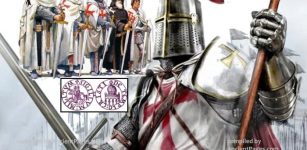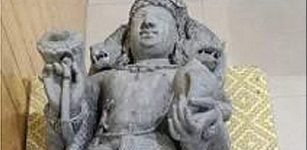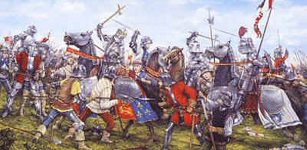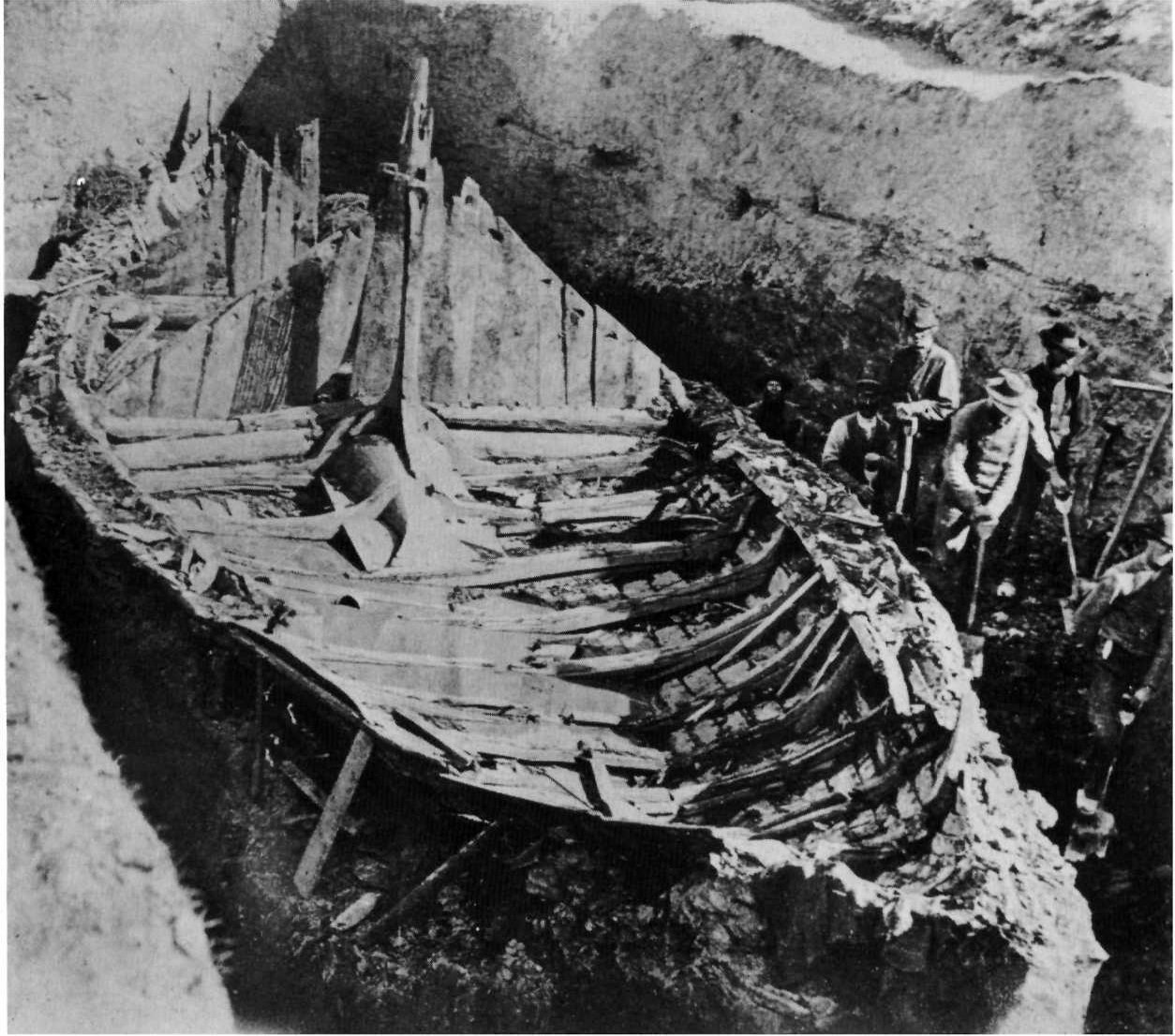Viking Longships: Fearless Dragonships Daring The Oceans And Seas
Ellen Lloyd - AncientPages.com - The Vikings were the lords of the oceans. One of the main reasons behind the Vikings' success in reaching distant lands lies in their remarkable longships. The Vikings’ ships were the European Dark Ages' greatest technical and artistic achievement. Without these great ships, the Viking Age would never have happened.
Viking warrior with a sword standing near Drakkar on the seashore. Credit: Adobe Stock - Nejron Photo
During the Viking era, there were different classes of ships. The longships were mainly used as warships, and the ships called Knarrs (or knorrs in Old Norse) served as slower passenger and cargo ships.
Viking longships were fast and could sail in shallow water. This gave the Vikings the possibility to travel up rivers as well as across the sea. In a raid, a ship could be hauled up on a beach. To surprise your enemy was an important strategic military tactic that gave the Vikings several advantages. The Vikings could jump out, start fighting, and then quickly get away if they were chased.
Many Viking ships were equipped with a dragon head on the bow. The dragon was one of the most famous symbols of the Vikings. Vikings believed the dragon could protect them against evil spirits at sea.
Vikings built their ships beside a river or an inlet of the sea. A tall oak tree was cut to make the keel. The hull of the ships was made of overlapping planks and secured with iron rivets. This made the ships very strong. A wool string was dipped in tar and forced between the planks to prevent leaks.
One man worked a big steering oar at the back end, or stern, to steer the ship.
A Viking ship with a dragon head. Credit: Adobe Stock - mastclick
Dragonships were large longships with carved heads of dragons and other magical beings mounted on their stem. They were ships for chieftains and kings. The ship’s dragonhead was a visual message about the owner’s status.
His dragon with her sails of blue,
All bright and brilliant to the view,
High hoisted on the yard arms wide,
Carries great Canute o’er the tide.
Brave is the royal progress — fast
The proud ship’s keel obeys the mast,
Dashes through foam, and gains the land,
Raising a surge on Limfjord’s strand. (The Song of Canute, Saga of St. Olaf)
"The dragonhead should scare away enemies. It also had magical functions: It would provide protection for ships and crew – and it should ward off evil spirits both on land and sea. The Icelandic law code Grágás says that the dragonhead should be taken off the ship when the Vikings returned to their homestead, not to intimidate the spirits of their native land. (Grágás was used from about 930 and written down about 1117)
The dragonhead made it easy to recognize a certain ship. It clearly shows who the leader is and where the leader is in battle. The symbolic function of the dragonhead is enhanced by the fact that ships often were named after the magical animal that graced its prow."1
A dragon ship was usually between 30-50 meters long and could carry 40 and 60 oarsmen. The men slept and ate on the deck. There was some space below the deck for stores but no cabins. Two of the most famous Viking Ships, the Gokstad Viking ship, and the Oseberg ship, were found by archaeologists in Norway.
Both ships were buried in Viking funerals between AD 800 and 900 and are now in the Viking Ship Museum in Oslo, Norway.
It was in a longship that Leif Eriksson landed on the American coast around the year 1000, long before Columbus. Of course, all other famous Viking warriors used longships when they traveled to other countries.
The longships were more or less invincible and gave the Vikings a vital advantage when they went to war or raids.
Updated on January 17, 2024
Written by – Ellen Lloyd - AncientPages.com
Copyright © AncientPages.com All rights reserved. This material may not be published, broadcast, rewritten or redistributed in whole or part without the express written permission of AncientPages.com
Expand for referencesMore From Ancient Pages
-
 10 Great Ancient Mysteries Of Africa
Civilizations | Mar 12, 2017
10 Great Ancient Mysteries Of Africa
Civilizations | Mar 12, 2017 -
 Tile Tomb Dated To The Late Hellenistic Era – Discovered In Surroundings Of Istanbul, Turkey
Archaeology | Jun 6, 2022
Tile Tomb Dated To The Late Hellenistic Era – Discovered In Surroundings Of Istanbul, Turkey
Archaeology | Jun 6, 2022 -
 Mystery Of The Giant Hand At The Temple Of Hercules
Featured Stories | Jul 17, 2019
Mystery Of The Giant Hand At The Temple Of Hercules
Featured Stories | Jul 17, 2019 -
 Discovered 3,700-Year-Old Clay Tablet Shows Babylonians Used Geometry Long Before Pythagoras
Archaeology | Aug 4, 2021
Discovered 3,700-Year-Old Clay Tablet Shows Babylonians Used Geometry Long Before Pythagoras
Archaeology | Aug 4, 2021 -
 Knights Templar – Strict Rules For Clothing And Eating Habits
Featured Stories | Jan 2, 2018
Knights Templar – Strict Rules For Clothing And Eating Habits
Featured Stories | Jan 2, 2018 -
 Has The Mystery Of The Hobbits Finally Been Solved?
Archaeology | Apr 21, 2017
Has The Mystery Of The Hobbits Finally Been Solved?
Archaeology | Apr 21, 2017 -
 The 5,500-Year-Old Underground Rock Settlement With Illuminated Galleries In Ancient City Of Hadrianopolis, Turkey
Archaeology | Sep 18, 2023
The 5,500-Year-Old Underground Rock Settlement With Illuminated Galleries In Ancient City Of Hadrianopolis, Turkey
Archaeology | Sep 18, 2023 -
 Mysterious Ancient Ghost City Of Bhangarh And The Curse Of The Holy “Magician”
Hindu Mythology | Sep 22, 2015
Mysterious Ancient Ghost City Of Bhangarh And The Curse Of The Holy “Magician”
Hindu Mythology | Sep 22, 2015 -
 The Brujo De Chiloé – The Wild Warlocks Of The Chiloé Archipelago
Featured Stories | May 4, 2022
The Brujo De Chiloé – The Wild Warlocks Of The Chiloé Archipelago
Featured Stories | May 4, 2022 -
 Unknown Aspect Of Human Evolution Discovered Through Ancient DNA Study
Archaeology | Nov 1, 2022
Unknown Aspect Of Human Evolution Discovered Through Ancient DNA Study
Archaeology | Nov 1, 2022 -
 2,000-Year-Old Buddhist Complex Unearthed In Northern Swat, Pakistan
Archaeology | Feb 20, 2021
2,000-Year-Old Buddhist Complex Unearthed In Northern Swat, Pakistan
Archaeology | Feb 20, 2021 -
 Norse Shamanism: A Völva And Her Prophecies Were Feared Among Norse Gods And Vikings
Featured Stories | May 19, 2020
Norse Shamanism: A Völva And Her Prophecies Were Feared Among Norse Gods And Vikings
Featured Stories | May 19, 2020 -
 Why Was The Dmanisis Gora Fortress Community So Resilient In The Transition From The Bronze To Iron Age
Archaeology | Jun 5, 2023
Why Was The Dmanisis Gora Fortress Community So Resilient In The Transition From The Bronze To Iron Age
Archaeology | Jun 5, 2023 -
 Scientists Unravel Why Humans Used Tiny Flakes 300,000 Years Ago
Archaeology | Dec 15, 2022
Scientists Unravel Why Humans Used Tiny Flakes 300,000 Years Ago
Archaeology | Dec 15, 2022 -
 Sculpture Of Lord Vishnu Dated To The Early 9th Century Found In Kashmir
Archaeology | Aug 4, 2022
Sculpture Of Lord Vishnu Dated To The Early 9th Century Found In Kashmir
Archaeology | Aug 4, 2022 -
 On This Day In History: The Battle of Blore Heath – Sep 23, 1459
News | Sep 23, 2015
On This Day In History: The Battle of Blore Heath – Sep 23, 1459
News | Sep 23, 2015 -
 Bizarre Devil’s Tramping Ground In North Carolina Is Avoided By People And Animals
Featured Stories | May 1, 2019
Bizarre Devil’s Tramping Ground In North Carolina Is Avoided By People And Animals
Featured Stories | May 1, 2019 -
 World’s Oldest And Largest Maya Structure Revealed By LIDAR
Archaeology | Jun 9, 2020
World’s Oldest And Largest Maya Structure Revealed By LIDAR
Archaeology | Jun 9, 2020 -
 Ancient Underwater ‘Lion City’ Rests Beneath The Thousand Island Lake
News | Feb 11, 2014
Ancient Underwater ‘Lion City’ Rests Beneath The Thousand Island Lake
News | Feb 11, 2014 -
 Ancient Pathogens Released From Melting Ice Could Wreak Havoc On The World – New Analysis Reveals
Featured Stories | Aug 2, 2023
Ancient Pathogens Released From Melting Ice Could Wreak Havoc On The World – New Analysis Reveals
Featured Stories | Aug 2, 2023



